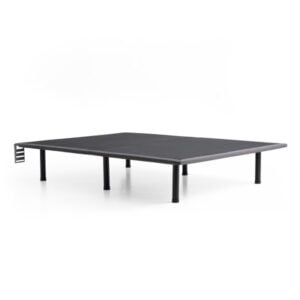Perfecting Your Side Sleeping Position: Tips and Tricks
Finding the Best Side Sleeping Position
Achieving the perfect side sleeping position can significantly enhance your sleep quality and how you feel each morning. Here’s a concise guide to get you started:
1. Head and Neck Alignment: Use a supportive, medium-density pillow to keep your head aligned with your neck.
2. Hip Alignment: Maintain hip alignment by placing a pillow between your knees or using a body pillow.
3. Mattress Choice: Opt for a medium-firm mattress to ensure even support across your body.
Now, let’s delve deeper into how to perfect your side sleeping position for a rejuvenating night’s sleep.
The Benefits of Side Sleeping
Sleeping on your side isn’t just cozy; it offers several health benefits. Here’s why this position might be the right choice for you:
Reduced Snoring
One of the most notable benefits of side sleeping is its ability to reduce snoring. This position helps to keep your airways open, unlike sleeping on your back, where the tongue can obstruct airflow. A review in Sleep & Breathing suggests that positional therapy, like side sleeping, significantly lessens snoring and sleep apnea symptoms.
Improved Digestion
For those struggling with acid reflux or heartburn, side sleeping—particularly on the left side—can be a game changer. Research published in The American Journal of Gastroenterology indicates that left-side sleeping lowers acid reflux occurrences by preventing stomach acid from flowing back into the esophagus.
Enhanced Brain Health
Believe it or not, your sleep position impacts your brain health. A study from Stony Brook University found that side sleeping may enhance the brain’s waste removal process, potentially lowering the risk of neurodegenerative diseases, like Alzheimer’s. This clearance is most effective during sleep, highlighting the importance of a good sleeping position.
Pain Relief
Side sleeping can alleviate chronic back and hip pain by promoting neutral spinal alignment. Using a pillow between your knees can further reduce pressure, leading to a more restful experience. A study featured in BMJ Open confirmed that proper side sleeping could diminish back pain significantly in just a month.
These benefits underline the importance of not just choosing to sleep on your side but doing so correctly. Let’s review how to achieve the ideal side sleeping posture.
Achieving Proper Side Sleeping Position
Head and Neck Alignment
To perfect your side sleeping position, start by ensuring your head and neck are aligned. This alignment is essential for avoiding neck pain upon waking. Your head should rest in a neutral position, neither tilted upwards nor downwards. Aim for a straight line from your neck to your spine.
Utilize a medium-density pillow with a 3–4-inch gusset, as research shows this type promotes optimal neck alignment and minimizes pressure.
Arm and Leg Placement
Your arms and legs also play a significant role in comfort.
– Pillow between knees: This will help align your hips and alleviate lower back pressure. A body pillow can offer additional support if needed.
– Arms position: Keep your arms below your face or straight down at your sides. This avoids shoulder strain and maintains a natural spinal curve.
– Slight knee bend: A gentle bend in your knees aids spinal alignment and helps decrease back strain.
Mattress Firmness
The firmness of your mattress greatly influences your sleeping experience. A medium-firm mattress usually works best for side sleepers, delivering an optimal balance of comfort and support. Research published in Applied Ergonomics demonstrates that this type of mattress helps prevent your hips and shoulders from sinking too deeply, which can lead to discomfort.
Selecting the Right Mattress and Pillows
Best Mattresses for Side Sleepers
For side sleepers, a medium-firm mattress serves as the best choice. Such a mattress balances support and comfort effectively, assisting in spinal alignment while minimizing pressure points.
Memory foam mattresses are particularly appealing to side sleepers, as they contour to your body for optimal support. For an eco-friendly option, consider the Eco Mattress from Parachute, which features firmer support in the center and softer zones at the head and feet.
Best Pillows for Side Sleepers
Choosing the right pillow is just as critical as selecting your mattress. A medium-density pillow with a 3–4 inch gusset works best, ensuring head and neck alignment while preventing strain. Consider pillows designed specifically for neck support or orthopedic options that maintain the natural curve of your neck.
A body pillow can also enhance your side sleeping experience, offering additional spinal alignment and hip support. For extra comfort, a knee pillow placed between your knees can help relieve lower back pressure.
Tips for Avoiding Shoulder and Hip Pain
Shoulder Pain Prevention
To prevent shoulder pain while side sleeping, consider these tips:
– Neutral Head Position: Maintain your head in a neutral position, aligned with your spine, with adequate pillow support.
– Shoulder-Hip Alignment: Ensure that your shoulders are aligned with your hips to prevent twisting your body, which can lead to discomfort.
– Alternating Sides: Frequently switching sides can help distribute pressure evenly, alleviating prolonged strain on one shoulder.
Hip Pain Prevention
To support your hips and mitigate pain:
– Pillow Between Knees: Placing a pillow between your knees keeps your hips aligned and alleviates pressure on your lower back.
– Medium-Firm Mattress: A mattress that is too soft can cause your hips to sink unnecessarily. Opting for a medium-firm mattress strikes the right balance.
– Body Pillow Support: Using a body pillow provides extra support and helps prevent your body from twisting during the night.
By following these practices, you can significantly reduce shoulder and hip pain and enjoy a more restorative night’s sleep.
Frequently Asked Questions about Proper Side Sleeping Position
Is it better to sleep on the right or left side?
Left-side sleeping brings unique benefits, including reduced heartburn and improved blood flow during pregnancy. However, those with specific heart conditions may find the right side more comfortable to alleviate discomfort.
What constitutes proper alignment for side sleeping?
Proper alignment involves keeping your head and neck in a neutral position, using a supportive pillow, placing a pillow between your knees, and ensuring your arms are beneath your face slightly bent. This will facilitate optimal spinal alignment.
What should I do with my arms while sleeping on my side?
Keep your arms beneath your face and slightly bent to prevent excessive pressure on your shoulders. Using a body pillow can also help maintain a comfortable position for your arms throughout the night.
Conclusion
Perfecting your side sleeping position is essential for enhancing your sleep quality and overall well-being. By implementing the tips and guidelines shared, you can ensure a pain-free, restful night’s sleep.
Explore our range of mattresses and pillows designed specifically for side sleepers. At Yawnder, we’re committed to helping you achieve the perfect side sleeping position through products tailored to your needs.
Elevate your sleep quality and transform your nights—after all, when you sleep better, you live better!













